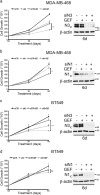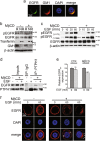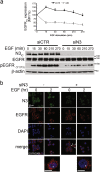NOTCH3 inactivation increases triple negative breast cancer sensitivity to gefitinib by promoting EGFR tyrosine dephosphorylation and its intracellular arrest
- PMID: 29795369
- PMCID: PMC5968025
- DOI: 10.1038/s41389-018-0051-9
NOTCH3 inactivation increases triple negative breast cancer sensitivity to gefitinib by promoting EGFR tyrosine dephosphorylation and its intracellular arrest
Abstract
Notch dysregulation has been implicated in numerous tumors, including triple-negative breast cancer (TNBC), which is the breast cancer subtype with the worst clinical outcome. However, the importance of individual receptors in TNBC and their specific mechanism of action remain to be elucidated, even if recent findings suggested a specific role of activated-Notch3 in a subset of TNBCs. Epidermal growth factor receptor (EGFR) is overexpressed in TNBCs but the use of anti-EGFR agents (including tyrosine kinase inhibitors, TKIs) has not been approved for the treatment of these patients, as clinical trials have shown disappointing results. Resistance to EGFR blockers is commonly reported. Here we show that Notch3-specific inhibition increases TNBC sensitivity to the TKI-gefitinib in TNBC-resistant cells. Mechanistically, we demonstrate that Notch3 is able to regulate the activated EGFR membrane localization into lipid rafts microdomains, as Notch3 inhibition, such as rafts depletion, induces the EGFR internalization and its intracellular arrest, without involving receptor degradation. Interestingly, these events are associated with the EGFR tyrosine dephosphorylation at Y1173 residue (but not at Y1068) by the protein tyrosine phosphatase H1 (PTPH1), thus suggesting its possible involvement in the observed Notch3-dependent TNBC sensitivity response to gefitinib. Consistent with this notion, a nuclear localization defect of phospho-EGFR is observed after combined blockade of EGFR and Notch3, which results in a decreased TNBC cell survival. Notably, we observed a significant correlation between EGFR and NOTCH3 expression levels by in silico gene expression and immunohistochemical analysis of human TNBC primary samples. Our findings strongly suggest that combined therapies of TKI-gefitinib with Notch3-specific suppression may be exploited as a drug combination advantage in TNBC treatment.
Conflict of interest statement
The authors declare that they have no conflict of interest.
Figures







Similar articles
-
Epidermal growth factor receptor as a potential therapeutic target in triple-negative breast cancer.Ann Oncol. 2009 May;20(5):862-7. doi: 10.1093/annonc/mdn710. Epub 2009 Jan 15. Ann Oncol. 2009. PMID: 19150933
-
The scaffolding protein NHERF1 sensitizes EGFR-dependent tumor growth, motility and invadopodia function to gefitinib treatment in breast cancer cells.Int J Oncol. 2015 Mar;46(3):1214-24. doi: 10.3892/ijo.2014.2805. Epub 2014 Dec 19. Int J Oncol. 2015. PMID: 25530180
-
IL-26 mediates epidermal growth factor receptor-tyrosine kinase inhibitor resistance through endoplasmic reticulum stress signaling pathway in triple-negative breast cancer cells.Cell Death Dis. 2021 May 21;12(6):520. doi: 10.1038/s41419-021-03787-5. Cell Death Dis. 2021. PMID: 34021125 Free PMC article.
-
An update of the mechanisms of resistance to EGFR-tyrosine kinase inhibitors in breast cancer: Gefitinib (Iressa) -induced changes in the expression and nucleo-cytoplasmic trafficking of HER-ligands (Review).Int J Mol Med. 2007 Jul;20(1):3-10. Int J Mol Med. 2007. PMID: 17549382 Review.
-
A perspective on anti-EGFR therapies targeting triple-negative breast cancer.Am J Cancer Res. 2016 Aug 1;6(8):1609-23. eCollection 2016. Am J Cancer Res. 2016. PMID: 27648353 Free PMC article. Review.
Cited by
-
Notch Signaling Activation as a Hallmark for Triple-Negative Breast Cancer Subtype.J Oncol. 2019 Jul 11;2019:8707053. doi: 10.1155/2019/8707053. eCollection 2019. J Oncol. 2019. PMID: 31379945 Free PMC article. Review.
-
Notch3 contributes to T-cell leukemia growth via regulation of the unfolded protein response.Oncogenesis. 2020 Oct 18;9(10):93. doi: 10.1038/s41389-020-00279-7. Oncogenesis. 2020. PMID: 33071287 Free PMC article.
-
Two Sides of the Same Coin: The Role of Developmental pathways and pluripotency factors in normal mammary stem cells and breast cancer metastasis.J Mammary Gland Biol Neoplasia. 2020 Jun;25(2):85-102. doi: 10.1007/s10911-020-09449-0. Epub 2020 Apr 22. J Mammary Gland Biol Neoplasia. 2020. PMID: 32323111 Free PMC article. Review.
-
Potentiating Therapeutic Effects of Epidermal Growth Factor Receptor Inhibition in Triple-Negative Breast Cancer.Pharmaceuticals (Basel). 2021 Jun 18;14(6):589. doi: 10.3390/ph14060589. Pharmaceuticals (Basel). 2021. PMID: 34207383 Free PMC article. Review.
-
Notch Signalling in Breast Development and Cancer.Front Cell Dev Biol. 2021 Jul 6;9:692173. doi: 10.3389/fcell.2021.692173. eCollection 2021. Front Cell Dev Biol. 2021. PMID: 34295896 Free PMC article. Review.
References
LinkOut - more resources
Full Text Sources
Other Literature Sources
Research Materials
Miscellaneous

